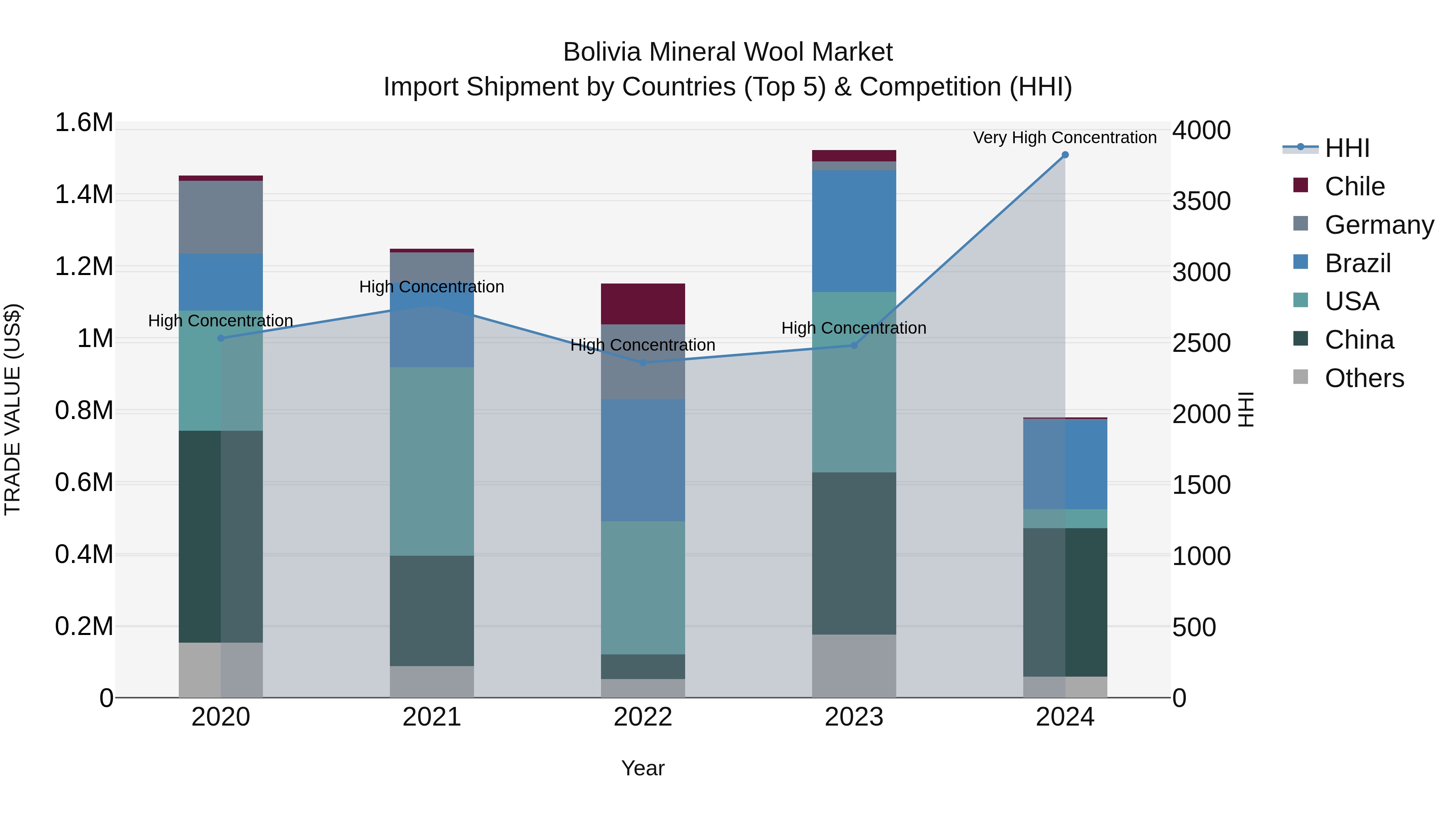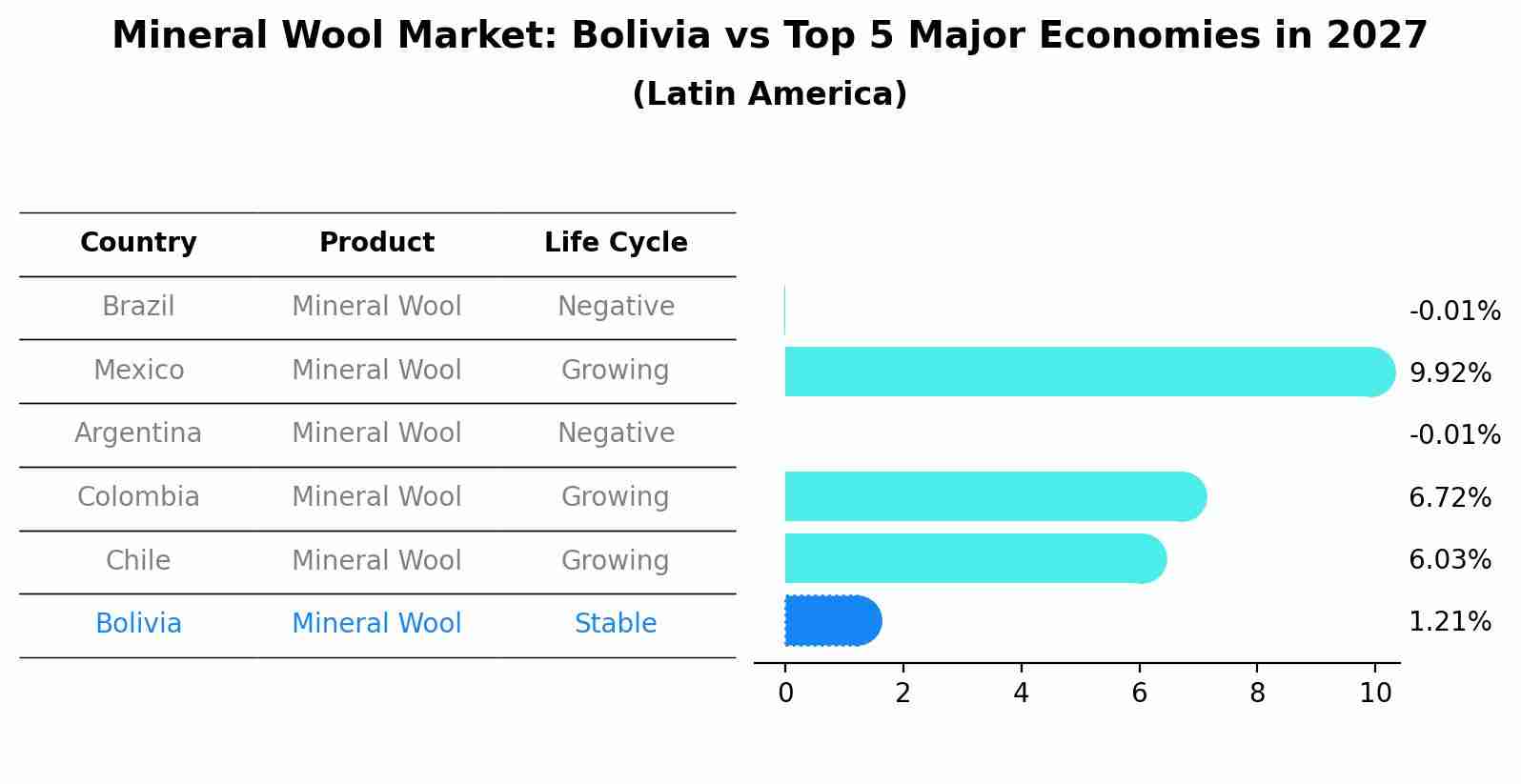Bolivia Mineral Wool Market (2025-2031) | Outlook, Segmentation, Size, Analysis, Share, Forecast, Trends, Revenue, Growth, Companies, Industry & Value
| Product Code: ETC4653278 | Publication Date: Nov 2023 | Updated Date: Nov 2025 | Product Type: Market Research Report | |
| Publisher: 6Wresearch | Author: Shubham Deep | No. of Pages: 60 | No. of Figures: 30 | No. of Tables: 5 |
Bolivia Mineral Wool Market Top 5 Importing Countries and Market Competition (HHI) Analysis
Bolivia mineral wool import market saw a significant shift in 2024, with top exporters including China, Brazil, USA, Sweden, and Argentina. The high concentration of the Herfindahl-Hirschman Index (HHI) in 2023 intensified to very high levels in 2024, indicating a more consolidated market. The compound annual growth rate (CAGR) for 2020-2024 was negative at -14.41%, with a steep decline in growth rate from 2023 to 2024 at -48.81%. This data suggests a challenging landscape for mineral wool imports in Bolivia, signaling potential shifts in market dynamics and competitive pressures.

Mineral Wool Market: Bolivia vs Top 5 Major Economies in 2027 (Latin America)
The Mineral Wool market in Bolivia is projected to grow at a stable growth rate of 1.21% by 2027, within the Latin America region led by Brazil, along with other countries like Mexico, Argentina, Colombia and Chile, collectively shaping a dynamic and evolving market environment driven by innovation and increasing adoption of emerging technologies.

Bolivia Mineral Wool Market Overview
The Bolivia mineral wool market involves the production and use of mineral wool products, such as insulation materials made from molten rock or slag. Mineral wool is used for thermal and acoustic insulation in construction and industrial applications. The market is driven by the growing construction industry, increasing demand for energy-efficient buildings, and regulations promoting sustainable building practices. As Bolivia continues to develop its infrastructure and focus on energy efficiency, the demand for mineral wool is likely to increase.
Drivers of the market
The Bolivia Mineral Wool Market is driven by the increasing demand for insulation materials in construction and industrial applications. Mineral wool, known for its thermal and acoustic insulation properties, is widely used in building projects to improve energy efficiency and comfort. The markets growth is supported by advancements in mineral wool technology, including improved fire resistance and environmental sustainability. Additionally, the rising emphasis on green building practices and energy-efficient construction contributes to the demand for mineral wool products.
Challenges of the market
Challenges in the Bolivia Mineral Wool Market include the high costs of production and the need to comply with environmental regulations. The production process for mineral wool involves significant energy consumption and raw material costs. Additionally, there are challenges related to market competition and the need to innovate to meet changing consumer demands and regulatory standards.
Government Policy of the market
The Bolivian government supports the mineral wool market as part of its efforts to promote sustainable construction practices. Policies focus on increasing the use of mineral wool for insulation and soundproofing in buildings. The government provides incentives for the production and use of environmentally friendly materials to improve energy efficiency and reduce environmental impact.
Key Highlights of the Report:
- Bolivia Mineral Wool Market Outlook
- Market Size of Bolivia Mineral Wool Market, 2024
- Forecast of Bolivia Mineral Wool Market, 2031
- Historical Data and Forecast of Bolivia Mineral Wool Revenues & Volume for the Period 2021-2031
- Bolivia Mineral Wool Market Trend Evolution
- Bolivia Mineral Wool Market Drivers and Challenges
- Bolivia Mineral Wool Price Trends
- Bolivia Mineral Wool Porter`s Five Forces
- Bolivia Mineral Wool Industry Life Cycle
- Historical Data and Forecast of Bolivia Mineral Wool Market Revenues & Volume By Product Type for the Period 2021-2031
- Historical Data and Forecast of Bolivia Mineral Wool Market Revenues & Volume By Rock Wool for the Period 2021-2031
- Historical Data and Forecast of Bolivia Mineral Wool Market Revenues & Volume By Glass Wool for the Period 2021-2031
- Historical Data and Forecast of Bolivia Mineral Wool Market Revenues & Volume By Form Types for the Period 2021-2031
- Historical Data and Forecast of Bolivia Mineral Wool Market Revenues & Volume By Board for the Period 2021-2031
- Historical Data and Forecast of Bolivia Mineral Wool Market Revenues & Volume By Blankets for the Period 2021-2031
- Historical Data and Forecast of Bolivia Mineral Wool Market Revenues & Volume By Panel for the Period 2021-2031
- Historical Data and Forecast of Bolivia Mineral Wool Market Revenues & Volume By Others for the Period 2021-2031
- Historical Data and Forecast of Bolivia Mineral Wool Market Revenues & Volume By Applications for the Period 2021-2031
- Historical Data and Forecast of Bolivia Mineral Wool Market Revenues & Volume By Building & Construction for the Period 2021-2031
- Historical Data and Forecast of Bolivia Mineral Wool Market Revenues & Volume By Industrial for the Period 2021-2031
- Historical Data and Forecast of Bolivia Mineral Wool Market Revenues & Volume By Transportation for the Period 2021-2031
- Historical Data and Forecast of Bolivia Mineral Wool Market Revenues & Volume By Others for the Period 2021-2031
- Bolivia Mineral Wool Import Export Trade Statistics
- Market Opportunity Assessment By Product Type
- Market Opportunity Assessment By Form Types
- Market Opportunity Assessment By Applications
- Bolivia Mineral Wool Top Companies Market Share
- Bolivia Mineral Wool Competitive Benchmarking By Technical and Operational Parameters
- Bolivia Mineral Wool Company Profiles
- Bolivia Mineral Wool Key Strategic Recommendations
Frequently Asked Questions About the Market Study (FAQs):
1 Executive Summary |
2 Introduction |
2.1 Key Highlights of the Report |
2.2 Report Description |
2.3 Market Scope & Segmentation |
2.4 Research Methodology |
2.5 Assumptions |
3 Bolivia Mineral Wool Market Overview |
3.1 Bolivia Country Macro Economic Indicators |
3.2 Bolivia Mineral Wool Market Revenues & Volume, 2021 & 2031F |
3.3 Bolivia Mineral Wool Market - Industry Life Cycle |
3.4 Bolivia Mineral Wool Market - Porter's Five Forces |
3.5 Bolivia Mineral Wool Market Revenues & Volume Share, By Product Type, 2021 & 2031F |
3.6 Bolivia Mineral Wool Market Revenues & Volume Share, By Form Types, 2021 & 2031F |
3.7 Bolivia Mineral Wool Market Revenues & Volume Share, By Applications, 2021 & 2031F |
4 Bolivia Mineral Wool Market Dynamics |
4.1 Impact Analysis |
4.2 Market Drivers |
4.2.1 Increasing demand for energy-efficient buildings and growing construction industry in Bolivia |
4.2.2 Rising awareness about the benefits of using mineral wool insulation for thermal and acoustic insulation |
4.2.3 Government initiatives promoting sustainable construction practices and energy efficiency |
4.3 Market Restraints |
4.3.1 Volatility in raw material prices affecting the production cost of mineral wool |
4.3.2 Lack of skilled labor for installation and application of mineral wool insulation |
4.3.3 Competition from alternative insulation materials such as fiberglass and foam |
5 Bolivia Mineral Wool Market Trends |
6 Bolivia Mineral Wool Market Segmentations |
6.1 Bolivia Mineral Wool Market, By Product Type |
6.1.1 Overview and Analysis |
6.1.2 Bolivia Mineral Wool Market Revenues & Volume, By Rock Wool, 2021-2031F |
6.1.3 Bolivia Mineral Wool Market Revenues & Volume, By Glass Wool, 2021-2031F |
6.2 Bolivia Mineral Wool Market, By Form Types |
6.2.1 Overview and Analysis |
6.2.2 Bolivia Mineral Wool Market Revenues & Volume, By Board, 2021-2031F |
6.2.3 Bolivia Mineral Wool Market Revenues & Volume, By Blankets, 2021-2031F |
6.2.4 Bolivia Mineral Wool Market Revenues & Volume, By Panel, 2021-2031F |
6.2.5 Bolivia Mineral Wool Market Revenues & Volume, By Others, 2021-2031F |
6.3 Bolivia Mineral Wool Market, By Applications |
6.3.1 Overview and Analysis |
6.3.2 Bolivia Mineral Wool Market Revenues & Volume, By Building & Construction, 2021-2031F |
6.3.3 Bolivia Mineral Wool Market Revenues & Volume, By Industrial, 2021-2031F |
6.3.4 Bolivia Mineral Wool Market Revenues & Volume, By Transportation, 2021-2031F |
6.3.5 Bolivia Mineral Wool Market Revenues & Volume, By Others, 2021-2031F |
7 Bolivia Mineral Wool Market Import-Export Trade Statistics |
7.1 Bolivia Mineral Wool Market Export to Major Countries |
7.2 Bolivia Mineral Wool Market Imports from Major Countries |
8 Bolivia Mineral Wool Market Key Performance Indicators |
8.1 Energy savings achieved by buildings using mineral wool insulation |
8.2 Number of construction projects incorporating mineral wool insulation |
8.3 Adoption rate of mineral wool insulation in the construction sector |
8.4 Number of government policies supporting the use of mineral wool insulation |
8.5 Environmental impact reduction attributed to the use of mineral wool insulation |
9 Bolivia Mineral Wool Market - Opportunity Assessment |
9.1 Bolivia Mineral Wool Market Opportunity Assessment, By Product Type, 2021 & 2031F |
9.2 Bolivia Mineral Wool Market Opportunity Assessment, By Form Types, 2021 & 2031F |
9.3 Bolivia Mineral Wool Market Opportunity Assessment, By Applications, 2021 & 2031F |
10 Bolivia Mineral Wool Market - Competitive Landscape |
10.1 Bolivia Mineral Wool Market Revenue Share, By Companies, 2024 |
10.2 Bolivia Mineral Wool Market Competitive Benchmarking, By Operating and Technical Parameters |
11 Company Profiles |
12 Recommendations | 13 Disclaimer |
- Single User License$ 1,995
- Department License$ 2,400
- Site License$ 3,120
- Global License$ 3,795
Search
Thought Leadership and Analyst Meet
Our Clients
Related Reports
- Germany Breakfast Food Market (2026-2032) | Industry, Share, Growth, Size, Companies, Value, Analysis, Revenue, Trends, Forecast & Outlook
- Australia Briquette Market (2025-2031) | Growth, Size, Revenue, Forecast, Analysis, Trends, Value, Share, Industry & Companies
- Vietnam System Integrator Market (2025-2031) | Size, Companies, Analysis, Industry, Value, Forecast, Growth, Trends, Revenue & Share
- ASEAN and Thailand Brain Health Supplements Market (2025-2031) | Strategy, Consumer Insights, Analysis, Investment Trends, Opportunities, Growth, Size, Share, Industry, Revenue, Segments, Value, Segmentation, Supply, Forecast, Restraints, Outlook, Competition, Drivers, Trends, Demand, Pricing Analysis, Competitive, Strategic Insights, Companies, Challenges
- ASEAN Bearings Market (2025-2031) | Strategy, Consumer Insights, Analysis, Investment Trends, Opportunities, Growth, Size, Share, Industry, Revenue, Segments, Value, Segmentation, Supply, Forecast, Restraints, Outlook, Competition, Drivers, Trends, Demand, Pricing Analysis, Competitive, Strategic Insights, Companies, Challenges
- Europe Flooring Market (2025-2031) | Outlook, Share, Industry, Trends, Forecast, Companies, Revenue, Size, Analysis, Growth & Value
- Saudi Arabia Manlift Market (2025-2031) | Outlook, Size, Growth, Trends, Companies, Industry, Revenue, Value, Share, Forecast & Analysis
- Uganda Excavator, Crane, and Wheel Loaders Market (2025-2031) | Strategy, Consumer Insights, Analysis, Investment Trends, Opportunities, Growth, Size, Share, Industry, Revenue, Segments, Value, Segmentation, Supply, Forecast, Restraints, Outlook, Competition, Drivers, Trends, Demand, Pricing Analysis, Competitive, Strategic Insights, Companies, Challenges
- Rwanda Excavator, Crane, and Wheel Loaders Market (2025-2031) | Strategy, Consumer Insights, Analysis, Investment Trends, Opportunities, Growth, Size, Share, Industry, Revenue, Segments, Value, Segmentation, Supply, Forecast, Restraints, Outlook, Competition, Drivers, Trends, Demand, Pricing Analysis, Competitive, Strategic Insights, Companies, Challenges
- Kenya Excavator, Crane, and Wheel Loaders Market (2025-2031) | Strategy, Consumer Insights, Analysis, Investment Trends, Opportunities, Growth, Size, Share, Industry, Revenue, Segments, Value, Segmentation, Supply, Forecast, Restraints, Outlook, Competition, Drivers, Trends, Demand, Pricing Analysis, Competitive, Strategic Insights, Companies, Challenges
Industry Events and Analyst Meet
Whitepaper
- Middle East & Africa Commercial Security Market Click here to view more.
- Middle East & Africa Fire Safety Systems & Equipment Market Click here to view more.
- GCC Drone Market Click here to view more.
- Middle East Lighting Fixture Market Click here to view more.
- GCC Physical & Perimeter Security Market Click here to view more.
6WResearch In News
- Doha a strategic location for EV manufacturing hub: IPA Qatar
- Demand for luxury TVs surging in the GCC, says Samsung
- Empowering Growth: The Thriving Journey of Bangladesh’s Cable Industry
- Demand for luxury TVs surging in the GCC, says Samsung
- Video call with a traditional healer? Once unthinkable, it’s now common in South Africa
- Intelligent Buildings To Smooth GCC’s Path To Net Zero


















